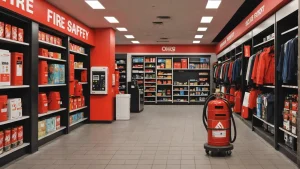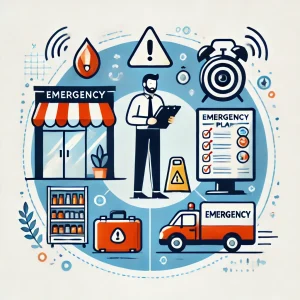As a retail store owner, ensuring the safety of your employees, customers, and property is paramount. In 2024, fire safety tips for retail stores should be at the top of your priority list.
But are you confident that your store is fully prepared to prevent and handle a potential fire emergency?
You shouldn’t wait until it’s too late to find out. This comprehensive fire safety checklist will help you identify and address critical areas to safeguard your own life and business from the devastating effects of a fire.
From developing an effective fire safety plan to installing essential equipment, we’ll guide you through the steps necessary to create a secure environment for everyone who enters your store.
What Are the Essential Fire Safety Tips for Retail Store Owners?
Fire safety is a critical responsibility for retail store owners. Neglecting this aspect of business operations can lead to devastating consequences, including property damage, injuries, and loss of life. To minimize these risks, it’s essential to implement a comprehensive fire safety checklist and follow best practices. By doing so, store owners can create a safe environment for their employees and customers while protecting their businesses from potential fire hazards. Ensure your retail establishment is equipped for unforeseen disasters by mastering the fundamentals of managing crises and emergencies in the retail sector.
Develop and Maintain a Fire Safety Plan
A well-crafted fire safety plan is the foundation of effective fire prevention and response. Every retail store should have a written plan that outlines emergency procedures and clearly defines the roles and responsibilities of employees during a fire emergency.
Create a written fire safety plan:
Identify potential fire hazards within the store, such as electrical equipment, flammable materials, and heat sources
Establish evacuation routes and assembly points for employees and customers
Assign specific roles to employees, such as fire wardens responsible for guiding people to safety and ensuring complete evacuation
Include contact information for emergency services and key personnel
Train employees on the plan and their roles:
Conduct thorough training sessions to familiarize employees with the fire safety plan
Ensure that all employees understand their specific roles and responsibilities during an emergency
Provide hands-on training on using fire extinguishers and other fire safety equipment
Regularly review and update the plan to reflect any changes in the store layout, personnel, or fire safety regulations
Install and Maintain Fire Protection Equipment For Fire Risk
Having the right fire safety equipment in place is essential for early detection and rapid response to fire emergencies. Retail store owners should invest in appropriate fire protection equipment and ensure that it is regularly maintained to guarantee proper functioning.
Equip the store with appropriate fire alarms and safety devices:
Install smoke detectors throughout the store, particularly in areas with high fire risk, such as storage rooms and electrical panels
Place fire extinguishers in easily accessible locations, ensuring that they are visible and not obstructed
Consider installing a sprinkler system, especially in larger stores or those with high-fire-risk merchandise
Regularly inspect fire load, and maintain fire safety equipment:
Conduct monthly inspections of smoke detectors, replacing batteries as needed
Have fire extinguishers professionally serviced and recharged annually
Test sprinkler systems and other fire suppression equipment according to manufacturer guidelines and local fire codes
Keep a log of all inspections, maintenance, and repairs for fire safety equipment
Conduct Regular Fire Drills
Fire drills are an essential component of fire safety training and preparedness. They help employees and customers familiarize themselves with evacuation procedures and identify potential issues that may arise during a real emergency.
Schedule and perform fire drills at least twice a year:
Plan fire drills, notifying employees of the upcoming drill
Conduct drills at different times and under various conditions to simulate real-life scenarios
Evaluate the effectiveness of each drill, noting any areas for improvement
Ensure all employees know evacuation routes and assembly points:
Mark evacuation routes and assembly points throughout the store
Post evacuation maps in prominent locations, such as employee break rooms and near exits
During drills, have designated fire wardens guide employees and customers to assembly points
Emphasize the importance of remaining calm and orderly during an evacuation
By implementing these essential fire safety tips, retail store owners can significantly reduce the risk of fires and minimize potential damage and injuries. Staying proactive and vigilant in fire safety efforts will help create a secure environment for employees and customers while protecting the business from the devastating consequences of a fire emergency.

The average Metrobi driver rating is 4.97 / 5.00
Metrobi drivers are highly rated by local businesses for their professionalism and reliability, giving you peace of mind with every delivery.
What Are the Essential Fire Safety Tips for Retail Store Owners?
Develop and Maintain a Fire Safety Plan
A well-crafted fire safety plan is the foundation of effective fire prevention and response in a retail store. This plan should be a written document that outlines emergency procedures, evacuation routes, and the roles and responsibilities of each employee during a fire emergency.
When creating the plan, key personnel from various departments should be involved to ensure all aspects of the store’s operations are considered. The plan should include:
A detailed floor plan with clearly marked emergency exits, fire extinguisher locations, and assembly points
Instructions for reporting a fire and activating the alarm system
Procedures for evacuating customers and employees, including those with disabilities
Guidelines for using fire extinguishers and other fire suppression equipment
Contact information for local emergency services and key store personnel
Once the plan is developed, it’s essential to train all employees on its contents and their specific roles during an emergency. Regular training sessions should be conducted for both new and existing employees to maintain a high level of preparedness.
Install and Maintain Fire Safety Equipment
Equipping your retail store with appropriate fire safety devices is a critical step in preventing and mitigating the impact of a fire.
Fire extinguishers are a first line of defense against small fires. Retail stores should have the appropriate type and number of extinguishers based on the store’s size, layout, and potential fire hazards.
Smoke detectors are essential for early fire detection and alarm activation. Install smoke detectors throughout the store, focusing on areas with a higher risk of fire, such as storage rooms and electrical panels. Regularly test and replace batteries to ensure proper functioning.
Automatic sprinkler systems can significantly reduce the spread and damage of a fire. If your retail store is equipped with a sprinkler system, ensure it is regularly inspected and maintained by a qualified professional.
Conduct Regular Fire Drills
Fire drills are an essential component of a comprehensive fire safety plan. They provide an opportunity for employees to practice emergency procedures and identify potential issues or improvements in the evacuation process.
Schedule and perform fire drills at least twice a year, involving all employees and departments. During the drill, focus on:
Activating the alarm system and notifying emergency services
Guiding customers and employees to designated evacuation routes and assembly points
Assisting individuals with disabilities or special needs
Ensuring all areas of the store are cleared and accounted for
After each drill, conduct a debriefing session with employees to discuss the drill’s effectiveness and identify areas for improvement. Update the fire safety plan as needed based on the feedback and observations from the drills.
Manage Electrical and Flammable Materials
Electrical malfunctions and flammable materials are common causes of retail store fires. To minimize these risks:
Regularly inspect electrical systems and appliances for wear, damage, or overloading
Use only certified electrical equipment and follow manufacturer guidelines for usage and maintenance
Store flammable materials, such as cleaning supplies and merchandise, in designated areas away from heat sources and electrical equipment
Ensure proper ventilation in storage areas to prevent the buildup of flammable vapors
Keep Exits and Pathways Clear
In the event of a fire, clear and accessible emergency exits and pathways are crucial for the safe evacuation of customers and employees. Regularly check and maintain exit routes by:
Ensuring all exit doors are unlocked and easily openable from the inside during business hours
Keeping exit pathways free of obstacles, such as boxes, merchandise, or debris
Marking exit signs and ensuring they are well-lit and visible
Regularly inspecting emergency lighting and backup power systems to ensure proper functioning during a power outage
By prioritizing these essential fire safety tips for retail stores, retail store owners can create a safer environment for their business, employees, and customers, while also complying with local fire codes and regulations.
Benefits of Implementing a Fire Safety Checklist for Retail Stores
Compliance with NFPA Regulations
In 2024, the National Fire Protection Association (NFPA) continues to update and enforce fire safety regulations for retail stores. Over the past year, the NFPA has focused on improving fire safety education and training programs for store owners and employees. This initiative aims to ensure that all retail establishments are well-prepared to prevent and respond to fire emergencies.
One of the key updates to NFPA regulations in 2024 is the mandatory installation of interconnected smoke alarms in all retail spaces, regardless of size. This requirement helps ensure early detection of fires, giving employees and customers more time to evacuate safely. Store owners who fail to comply with this regulation may face hefty fines and potential legal consequences.
Enhanced Employee and Customer Safety
Protecting the lives of employees and customers is the top priority for any retail store owner. In 2024, the retail industry has seen a renewed focus on fire safety training for employees. Store owners are investing in comprehensive workplace training programs that cover fire prevention, evacuation procedures, and the proper use of fire extinguishers.
Regular fire drills have become more common in retail establishments over the past year, ensuring that employees are prepared to handle emergencies. These drills not only help employees respond quickly and effectively to fires but also provide customers with a sense of security and confidence in the store’s commitment to safety.
Protection of Property and Inventory
Fire can devastate a retail business, causing significant damage to property and inventory. In 2024, store owners are increasingly investing in advanced fire suppression systems to minimize the risk of property damage. These systems, such as fire sprinklers and fire-resistant materials, can help contain fires and limit their spread, reducing the overall impact on the store.
In addition to fire suppression systems, many retail businesses are now opting for comprehensive fire insurance policies. These policies provide financial protection in the event of a fire, helping store owners recover from potential losses and resume operations more quickly.
The cost of a fire can be staggering for a retail business, often leading to significant financial losses. By implementing a fire safety checklist and investing in prevention strategies, store owners can minimize the risk of such losses. In the past year, industry experts have emphasized the importance of regular fire safety audits to identify potential hazards and address them before they lead to costly fires.
As the retail industry continues to prioritize fire safety in 2024 and beyond, store owners who adopt comprehensive, fire safety protocols and checklists will be well-positioned to protect their businesses, employees, and customers. By staying compliant with NFPA regulations, investing in employee training, and implementing effective prevention strategies, retail store owners can create a safer environment for all stakeholders while minimizing the risk of financial losses and legal liabilities.
Fire Prevention Strategies for Retail Businesses
Preventing fires in retail stores is crucial for ensuring the safety of employees, customers, and the business itself. By following these fire prevention strategies, store owners can significantly reduce the risk of fires and minimize potential damage.
Proper Storage and Handling of Flammable Materials
Flammable materials, such as cleaning products, aerosols, paper products, and certain merchandise, pose a significant fire risk if not stored and handled properly. To minimize this fire risk assessment, retail store owners should:
Designate specific areas for storing flammable materials, ensuring they are away from heat sources, electrical equipment, and other potential ignition points. These storage areas should be well-ventilated and equipped with appropriate fire suppression systems, such as sprinklers or fire extinguishers.
Use appropriate containers and labels for flammable liquids. Flammable liquids should be stored in approved safety containers with tight-fitting lids to prevent spills and leaks. These containers should be clearly labeled with the contents and appropriate hazard warnings, making it easy for employees to identify and handle them safely.
To ensure proper handling of flammable materials, retail store owners should provide comprehensive training to their employees. This training should cover:
Identifying flammable materials commonly found in the store
Safe handling and storage procedures for flammable materials
Emergency response protocols in case of spills or leaks
Proper use of personal protective equipment (PPE) when handling flammable materials
Regular refresher training sessions should be conducted to keep employees updated on best fire danger practices and maintain a strong culture of fire safety within the organization.
Regular Inspection and Maintenance of Electrical Systems
Electrical malfunctions are a leading cause of fires in retail establishments. To minimize this risk, store owners should:
Schedule professional inspections of electrical wiring and appliances at least once a year. A licensed electrician should thoroughly examine the store’s electrical system, including wiring, outlets, switches, and appliances, to identify any potential hazards or areas that require repairs or upgrades.
Repair or replace faulty electrical components promptly. If any electrical issues are identified during inspections or reported by employees, store owners should take immediate action to address them. This may involve replacing worn-out wiring, repairing or replacing malfunctioning appliances, or upgrading electrical panels to meet current safety standards.
Retail store employees should be trained to recognize potential electrical hazards and report them to management promptly. This training should include:
Identifying signs of electrical malfunctions, such as flickering lights, buzzing sounds, or unusual odors
Avoiding overloading electrical outlets or using damaged extension cords
Reporting any electrical issues or concerns to management immediately
By fostering a culture of electrical safety awareness among employees, store owners can help prevent fires caused by electrical malfunctions.
Implementing a No Smoking Policy
Smoking is a significant fire hazard in retail environments, particularly when smoking materials are not properly extinguished or disposed of. To minimize this risk, retail store owners should:
Prohibit smoking within the store premises, including back rooms, storage areas, and employee break rooms. This policy should be communicated to all employees and customers through signage, employee handbooks, and verbal reminders.
Designate outdoor smoking areas away from flammable materials and building entrances. If smoking is allowed on the property, specific areas should be designated for smoking, ensuring they are located a safe distance from the store building, flammable storage areas, and other potential fire hazards. These areas should be equipped with proper ashtrays or cigarette receptacles to prevent littering and ensure smoking materials are fully extinguished.
To ensure compliance with the no-smoking policy, retail store owners should:
Include the policy in employee handbooks and training materials
Post clear signage throughout the store indicating that smoking is prohibited
Encourage employees to report any violations of the policy to management
Take appropriate disciplinary action against employees who violate the policy
By strictly enforcing a no-smoking policy, retail store owners can significantly reduce the risk of fires caused by smoking materials.
Implementing these fire prevention strategies is essential for creating a safe environment for employees and customers alike. By properly storing and handling flammable materials, regularly inspecting and maintaining electrical systems, and enforcing a strict no-smoking policy, retail store owners can significantly reduce the risk of fires and protect their businesses from potential damage and losses.
Key Components of a Fire Evacuation Plan for Retail Establishments
Clear and Well-Marked Evacuation Routes
Ensuring that evacuation routes are clearly marked and easily accessible is a critical aspect of any fire evacuation plan. Retail store owners should post evacuation route maps throughout the store, making sure they are visible and easy to understand. These maps should highlight the quickest and safest paths to exit the building in case of a fire emergency.
In addition to posting maps above fire doors, store owners must ensure that all fire exits are marked with illuminated signs and kept unobstructed at all times. This includes regularly checking that emergency doors are not blocked by merchandise, equipment, or other obstacles that could hinder a swift evacuation. Fire doors should also be maintained properly, ensuring they close and latch automatically to prevent the spread of fire and smoke.
Employees play a crucial role in guiding customers to safety during a fire emergency. Store owners should provide thorough training on evacuation procedures, ensuring that all staff members are familiar with the locations of exits and the proper steps to take in case of a fire. This training should be conducted regularly, especially for new hires, and should include hands-on practice drills to reinforce the importance of swift and orderly evacuation.
Designated Assembly Points
Once evacuated from the building, it’s essential to have a safe place for employees and customers to gather. Retail store owners should identify designated assembly points located a safe distance from the store, away from potential hazards such as falling debris or arriving emergency vehicles.
These assembly points should be communicated to all employees and included in the evacuation route maps posted throughout the store. In larger retail establishments, multiple assembly points may be necessary to accommodate the number of people evacuating and to ensure that everyone can gather safely without overcrowding.
Employee Roles and Responsibilities
Assigning specific roles and responsibilities to employees during a fire evacuation can help ensure a more organized and efficient process. Store owners should designate certain staff members to lead customers to exits, making sure that all areas of the store are cleared and no one is left behind. Other employees can be tasked with conducting headcounts at the designated assembly points to verify that everyone has safely evacuated.
All employees must be trained to understand their roles and responsibilities in the event of a fire. Store owners should provide regular training sessions to review these roles and conduct practice drills to familiarize staff with the evacuation process. This not only helps employees feel more prepared and confident in their workplace and their ability to handle an emergency but also demonstrates the store’s commitment to the safety of both staff and customers.
Accommodating Individuals with Disabilities
When crafting a fire evacuation plan, retail store owners must consider the needs of individuals with disabilities. This includes ensuring that evacuation routes are accessible for those with mobility impairments and providing clear visual and audible fire alarms for those with hearing or vision impairments.
Store owners should work with local fire departments and accessibility experts to develop strategies for safely evacuating individuals with disabilities. This may involve assigning specific employees to assist these individuals during an emergency or investing in specialized equipment, such as evacuation chairs or portable ramps.
Regularly Updating and Practicing the Plan
A fire evacuation plan is only effective if it is up-to-date and regularly practiced. Retail store owners should review and update their plans annually, or whenever significant changes occur within the store layout or operations. This ensures that the plan remains relevant and accounts for any new potential hazards or challenges.
In addition to regular updates, store owners should conduct periodic fire drills to allow employees and customers to practice the evacuation process. These drills not only help identify areas for improvement in the plan but also reinforce the importance of swift and orderly evacuation during a real emergency.
By implementing these key components and regularly reviewing and practicing their fire evacuation plan, retail store owners can significantly enhance the safety of their employees and customers, while also minimizing potential damage to their business in the event of a fire emergency.
Essential Fire Safety Equipment for Retail Store Owners
As a retail store owner, investing in essential fire safety equipment is crucial to protect your business, employees, and customers from the devastating consequences of a fire. There are many commercial fires equipment options in the market. By equipping your store with the right tools and systems, you can minimize the risk of fire-related injuries, property damage, and financial losses.
Fire Extinguishers
Fire extinguishers are the first line of defense against small fires in your retail store. It’s important to place appropriate fire extinguishers throughout the store, ensuring they are easily accessible and visible to employees and customers.
There are several types of fire extinguishers designed for different classes of fires:
Class A: Suitable for ordinary combustibles like paper, wood, and fabric
Class B: Designed for flammable liquids and gases
Class C: Intended for electrical equipment fires
Class D: Used for combustible metals
Class K: Specifically for kitchen fires involving cooking oils and fats
When selecting fire extinguishers for your retail store, consider the types of materials and potential fire hazards present in your establishment. A combination of Class A, B, and C fire extinguishers is recommended to cover the most common fire risks.
Strategically place fire extinguishers near exits, high-risk areas, and at regular intervals throughout the store. Ensure they are mounted securely on walls or stands, making them easily accessible during an emergency.
Regularly inspect and maintain your fire extinguishers according to the manufacturer’s guidelines and local fire codes. This includes checking the pressure gauge, ensuring the extinguisher is not damaged or leaking, and replacing expired or used extinguishers promptly.
Smoke Detectors and Alarms
Smoke detectors and alarms are essential for early fire detection and warning. Install smoke detectors in key areas of your retail store, such as sales floors, stockrooms, offices, and electrical equipment.
There are two main types of smoke detectors:
Ionization smoke detectors: These are more responsive to flaming fires and detect small particles of smoke
Photoelectric smoke detectors: These are more sensitive to smoldering fires and detect larger smoke particles
For optimal protection, it’s recommended to use a combination of both types or invest in dual-sensor smoke detectors that incorporate both technologies.
Follow local fire codes and manufacturer guidelines when installing smoke detectors in your retail store. Ensure they are placed on ceilings or high on walls, away from air vents and other obstructions that may interfere with their performance.
Test your smoke detectors regularly, at least once a month, to ensure they are functioning correctly. Replace batteries as needed, typically every six months to a year, or opt for hardwired smoke detectors with battery backups for added reliability.
Sprinkler Systems
Sprinkler systems provide an additional layer of fire suppression, automatically activating to control and extinguish fires in your retail store. While not mandatory in all retail establishments, installing a sprinkler system can significantly reduce the spread of fire and minimize property damage.
There are several types of sprinkler systems suitable for retail environments:
Wet pipe systems: These systems have water-filled pipes and are the most common type of sprinkler system
Dry pipe systems: These systems have pressurized air or nitrogen in the pipes, which is released before water flows, making them suitable for areas prone to freezing temperatures
Pre-action systems: These systems require both the detection of heat or smoke and the activation of a sprinkler head to release water, reducing the risk of accidental discharge
When selecting a sprinkler system for your retail store, consider factors such as the size of your establishment, the types of merchandise stored, and local building codes and regulations.
Sprinkler systems should be designed and installed by qualified professionals who adhere to local fire codes and standards. Ensure that the system provides adequate coverage throughout your retail store, including sales floors, stockrooms, and offices.
Regular maintenance and testing of your sprinkler system are crucial to ensure its proper functioning during a fire emergency. Schedule professional inspections and tests according to local regulations and manufacturer recommendations, typically on an annual basis.
By investing in essential fire safety equipment such as fire extinguishers, smoke detectors, and sprinkler systems, retail store owners can create a safer environment for their employees and customers. However, it’s equally important to provide comprehensive training to your staff on the proper use and maintenance of this equipment, ensuring they are prepared to respond effectively in the event of a fire emergency.
What is the Biggest Cause of Fires at Business Properties?
Electrical malfunctions are the leading cause of non-residential fires, responsible for nearly 20% of incidents
Other common causes include cooking equipment, heating equipment, and arson
Regular inspections, maintenance, and proper usage protocols can significantly reduce fire risks
Electrical Malfunctions: The Primary Culprit
Electrical malfunctions, including faulty wiring, overloaded circuits, and malfunctioning equipment, are the number one cause of fires in business properties. According to the National Fire Protection Association (NFPA), electrical issues account for 19% of all non-residential structure fires reported from 2013 to 2017.
To mitigate electrical fire risks, retail store owners should:
Schedule regular electrical inspections by licensed professionals
Ensure proper installation and maintenance of electrical systems and equipment
Avoid overloading circuits and extension cords
Replace damaged or frayed wiring promptly
Many older buildings have outdated electrical systems that struggle to meet the demands of modern retail operations. These aging systems are more prone to malfunctions and can pose significant fire hazards if not properly maintained or upgraded.
Retail store owners in older buildings should work with qualified electricians to assess their electrical infrastructure and make necessary updates to ensure compliance with current fire safety protocol and standard. This may involve replacing old wiring, upgrading electrical panels, and installing additional circuits to accommodate increased power demands.
Cooking Equipment Fires
Cooking equipment, such as stoves, ovens, and deep fryers, is another leading cause of fires in commercial properties. The NFPA reports that cooking equipment is responsible for 29% of fires in retail establishments.
To reduce the risk of cooking-related accidental fires further, retail store owners should:
Ensure proper installation and maintenance of cooking equipment
Train employees on safe cooking practices and fire prevention
Keep cooking areas clean and free of grease buildup
Install and maintain fire suppression systems in kitchen areas
Heating Equipment Malfunctions
Heating equipment, including furnaces, boilers, and space heaters, can also pose significant fire risks in retail stores. The NFPA attributes 11% of non-residential structure fires to heating equipment malfunctions.
To minimize fire risk and the risk of heating equipment fires, retail store owners should:
Schedule regular maintenance and inspections of heating systems
Ensure proper installation and use of heating equipment
Keep combustible materials away from heat sources
Educate employees on safe heating practices and fire prevention
Portable space heaters are a common cause of heating-related fires in retail stores. Employees may use these devices to provide supplemental heat in poorly insulated or drafty areas, but improper use can quickly lead to a fire.
To ensure safe use of space heaters, retail store owners should establish clear guidelines, such as:
Only allowing the use of UL-listed space heaters with automatic shut-off features
Requiring space heaters to be placed at least 3 feet away from combustible materials
Ensuring space heaters are plugged directly into wall outlets, not extension cords
Mandating that space heaters are turned off and unplugged when not in use
Arson Prevention
While not as common as other causes of many fires, arson still accounts for a significant portion of fires in commercial properties. The NFPA reports that 10% of non-residential structure fires are intentionally set.
To reduce the risk of arson, retail store owners can implement various security measures, such as:
Installing and maintaining security cameras and alarm systems
Ensuring adequate lighting in and around the store
Securing all entrances and exits when the store is closed
Conducting background checks on employees and contractors
Establishing a relationship with local law enforcement and fire departments
By understanding the primary causes of fires in business properties and taking proactive steps to address these risks, retail store owners can create a safer environment for their employees, customers, and assets.
Protecting Your Business, Employees, and Customers from Fire
Fire safety is a critical responsibility for retail store owners. By implementing a comprehensive fire safety checklist, developing a fire evacuation plan, and investing in essential fire safety equipment, you can significantly reduce the risk of fires and ensure a safe environment for your business, employees, and customers. Does your retail store have a robust plan for crisis handling? Discover the critical strategies for managing emergencies and crises in the retail sector.
Implementing these fire safety measures not only protects lives and property but also helps you stay compliant with NFPA regulations, minimizing legal liabilities and risks. You shouldn’t wait until it’s too late to prioritize fire safety in your retail store.
Take action today by reviewing your business safe current fire safety plan, training your employees, and ensuring that your store is equipped with the necessary fire safety equipment. Your proactive approach to fire safety will provide peace of mind for you, your employees, and your customers.
When was the last time you conducted a fire drill or inspected your store’s electrical systems? Schedule these important tasks now to ensure the continued safety of your retail establishment.

























